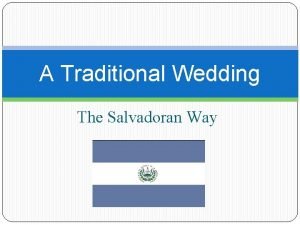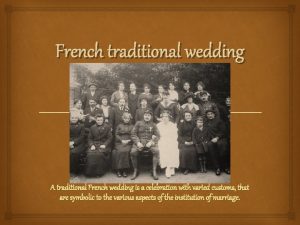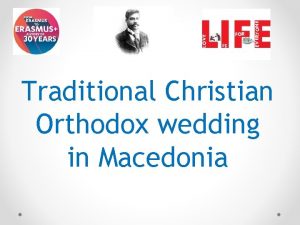A Traditional Wedding The Salvadoran Way The Engagement









- Slides: 9

A Traditional Wedding The Salvadoran Way

The Engagement Traditionally, it was not considered proper for couples to be seen together in public unless they were engaged or married, but this has changed a lot in urban areas. One tradition is asking the girl's father for permission. One month before the wedding, the groom asks the girl's father for permission to take the girl out of her family house. He goes to her house early in the morning with a band, if he can afford the expense. All the neighbors come to see the new bride and to tell her something nice.

The religion Many traditional Salvadoran weddings follow the Catholic tradition. The reception takes place in a Catholic church, or cathedral. The married couple with take communion at their wedding.

The Wedding Party – Who is Involved Traditionally in El Salvador, the groom’s father and the groom’s family pays for the wedding, even the bride’s wedding dress. Parents play an important role, they walk the bride through the street to the wedding place (church). The wedding couple’s godparents are very important during the wedding, too. The godparents are the people who are responsible for the spiritual growth of the kids. They have roles throughout the marriage ceremony. Many wedding parties are very large as the kids in the family play a part in the wedding.

Traditional Wedding Food "COMIDAS LATINAS" (LATIN FOOD) • Appetizers – “pasteles” are meat patties - “empanades” are pastries with meet and vegetables • Main meal – some people set up stations where you can make your own fajitas and tacos - other must-have dishes include rice and beans - paella, "arroz con pollo" (chicken with rice) -"ropa vieja" (beef stew) - fried plantains (bananas) - tamales - pupusas • Desserts - flan (custard made from milk, eggs, vanilla, and caramelized sugar) • Wedding Cakes – Some traditional wedding cakes are made with dried fruit and soaked in rum.

"BEBIDAS" (DRINKS) Some of the popular drinks are: Sangria - a punch that is made from wine, brandy, sugar, fruit, and soda water. Wine - Chile, Argentina, and Spain all produce excellent white, red, and sparkling wines. For non-alcoholic drinks, sodas come in many different kinds of tropical flavors, and "batidos" are fruit shakes made from fresh fruit, ice, and milk "cafe con leche" is often served with the wedding cake.

The Reception and the Dance Some of the popular kinds of music to play at a wedding are: Salsa Merengue Mambo Flamenco Samba Some people hire a mariachi band or a big band to get everyone dancing.

Customs and Traditions As part of some wedding ceremonies, thirteen gold coins, which represent the groom's wealth (money) are blessed by the priest, then passed back and forth between the bride and the groom. Then they put the coins down on a Bible. A large rope or rosary is wrapped around the shoulders of the couple in a figure 8 to show they will stay together.

The Wedding Dress: "vestido de bodas" Some brides chose to wear a dramatic mantilla veil, or a slim dress with a bolero jacket. Some pick a dress with Flamenco-style ruffles at the hem. Brides in many Latin-American countries wear a light blue petticoat or slip beneath their dresses. In Spain, brides wear black dresses to show their devotion until death. Touches of red and black, for both bride and groom, also add a Latin touch.















